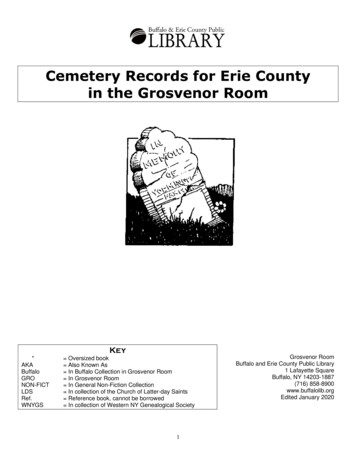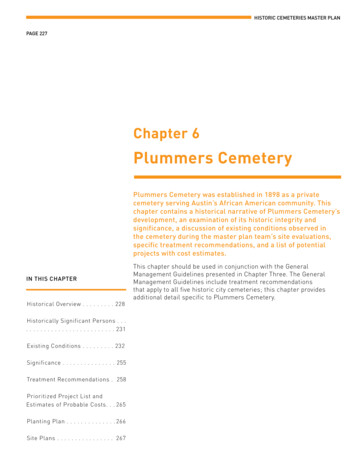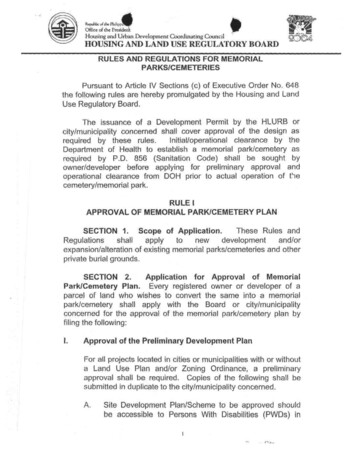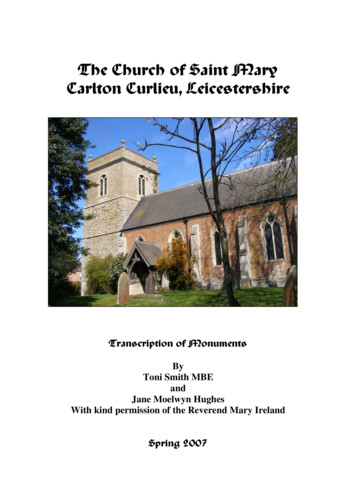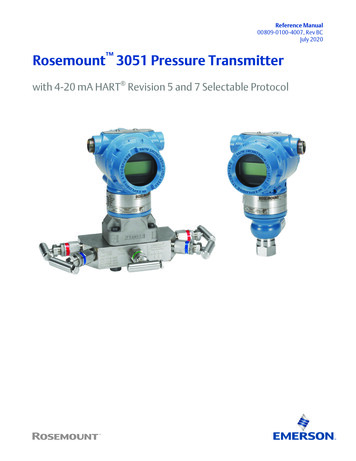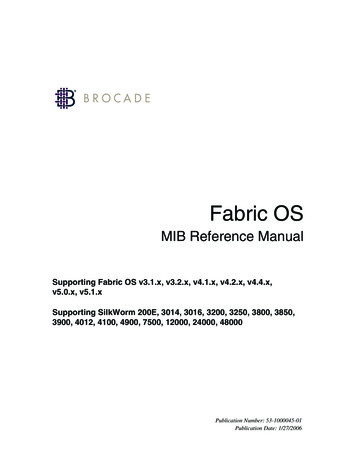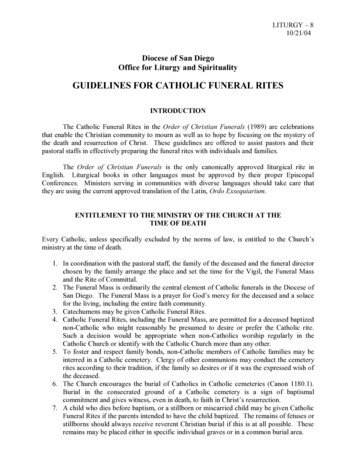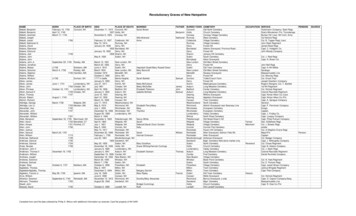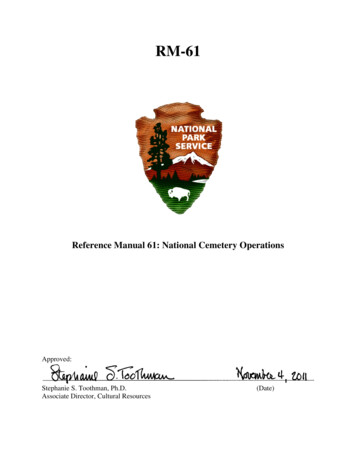
Transcription
RM-61Reference Manual 61: National Cemetery OperationsApproved:Stephanie S. Toothman, Ph.D.Associate Director, Cultural Resources(Date)
Table of Contents1. Background and Purpose2. Authority and Related Guidance3. Requirements and Instructions3.13.2Operation and Maintenance of National Cemeteries as Cultural Resources3.1.1Minimum Planning Requirements3.1.2Treatment and Use of Component Parts of National CemeteriesGeneral Provisions3.2.1Visitation3.2.2Cemetery-Specific Regulations3.2.3Access and Traffic Control3.2.4Floral Regulations3.2.5Filming and Photography3.3Eligibility for Interment in NPS-administered National Cemeteries3.4Interment Facilities and Services Provided3.53.4.1Basic Facilities and Services Provided3.4.2Viewing of Remains at NPS National Cemeteries3.4.3Military Honors3.4.4Interment Flag3.4.5Burial Vaults and Grave Liners3.4.6PallbearersPre-interment Actions and Related Matters3.5.1Scheduling of Interments2
3.63.73.83.5.2Environmental Considerations3.5.3Requests for Interments on Weekends and Holidays3.5.4Gravesite Assignment3.5.5Burial Permits3.5.6Opening the Grave3.5.7Accidental Damage3.5.8Side-by-Side Burials in a Single GravesiteThe Interment3.6.1General3.6.2Late Arrivals3.6.3Placement of Interment Flowers Delivered to the GravesitePrior to the Arrival of the Funeral Party3.6.4The Funeral Procession, Committal Service, and the Interment3.6.5Closing the Grave3.6.6Temporarily Marking the Grave3.6.7Recording the Interment3.6.8Interments Postponed Because of Weather, Weather-relatedConditions or EmergenciesCremated Remains and Group Burials3.7.1Scattering of Cremated Remains3.7.2Burial of Cremated Remains3.7.3Group BurialsDisinterments and Direct Exhumations3.8.1Disinterments3
3.93.8.2Directed Exhumations3.8.3Accidental Disinterment of Unmarked Remains3.8.4Accidental Disinterment within a Burial SectionHeadstones, Markers and Commemorative Monuments3.9.1General Guidance3.9.2Memorial Headstones and Markers3.9.3Commemorative Monuments3.9.4Repair and Replacement of Damaged Headstones3.9.5Errors of Fact3.10 Ceremonies and Special Events3.11 Flags4
1. Background and PurposeNPS-61, “Guideline for National Cemeteries,” (Release No. 1, November 1985) is replaced byDirector’s Order #61 and this Reference Manual. The purpose of this Reference Manual is tosupplement Director’s Order #61 (National Cemetery Operations) and provide guidance on theoperation of NPS-administered national cemeteries. The guidance and procedures containedherein are consistent with NPS national cemetery regulations published at 36 CFR part12, NPSManagement Policies 2006 and Director’s Order #61.The National Park Service currently manages 14 national cemeteries. These cemeteries areadministered to preserve the historic character, uniqueness, and solemn nature of both thecemeteries and the historical parks of which they are a part.National Cemeteries administered by the National Park Service are classified as either "active" or"closed." Active cemeteries have casket or cremation gravesites available for first interments.Closed cemeteries have no available gravesites for either casket or cremation first interments butmay inter eligible family members of previously interred individuals (See section 1 of Director’sOrder #61 and section 3.3 of this document).There are two active national cemeteries currently administered by the NPS: AndersonvilleNational Cemetery and Andrew Johnson National Cemetery. Antietam, Battleground,Chalmette, Fort Donelson, Fredericksburg, Gettysburg, Poplar Grove, Shiloh, Stones River,Vicksburg, Yorktown and Custer National Cemeteries are closed.2. Authority and Related GuidanceAuthority to issue this Reference Manual is contained in section 4 of Director’s Order #61:National Cemetery Operations, the NPS Organic Act (16 USC 1 through 4), and in delegationsof authority found in Part 245 of the DOI Manual. Other specific authorities and requirementsgoverning NPS administration of national cemeteries are found in Director’s Order #61 (NationalCemetery Operations), 36 CFR Part 12 (National Cemetery Regulations). National cemeteriesare addressed in section 8.6.10.1 of NPS Management Policies 2006.3. Requirements and Instructions3.1Operation and Maintenance of National Cemeteries as Cultural ResourcesNational cemeteries encompass all types of cultural resources, including sites, landscapes,structures, objects, and archival and collections items. The operation and maintenance ofnational cemeteries will broadly follow NPS policy and guidance for similar classes of culturalresources. These cultural resources will be identified and evaluated through appropriate andrelevant reports such as historic resource studies, cultural landscape reports, cultural resourceinventories, and National Register nominations. In addition, each national cemetery will have itsown legislative and administrative history or be included in the legislative and administrativehistory of the historical park in which the cemetery is located.
Cultural resource preservation policies found in chapter 5 of NPS Management Policies 2006,and Director’s Order #28 will be used to preserve and manage identified cultural resources.Headstones and markers will be treated in accordance with Director’s Order #61: NationalCemetery Operations, and with the policy and procedures contained in this Manual.3.1.1Minimum Planning RequirementsA. Required Documents1.Cultural Landscape Report and National Register DocumentationIn accordance with section 3.9.4 of Director’s Order #61, all NPS national cemeteries must haveeither an approved cultural landscape report (CLR) or National Register documentation thatadequately addresses the cultural landscape, identifies contributing landscape characteristics andfeatures, and establishes criteria for analyzing the historical significance and integrity of thelandscape. An approved cultural landscape report will be used to determine the historicsignificance of these resources and evaluate their relevance to the overall appearance of thecemetery.2.Administrative and Legislative HistoriesEach national cemetery will have its own legislative and administrative history or be included inthe legislative and administrative history of the park in which the cemetery is located. This isimportant if the legislation establishing the national cemetery predates that of the park.3.Interment PlanIn accordance with 36 CFR 12.5(d), each NPS national cemetery must have an approvedinterment plan for burial sections. This interment plan must be in keeping with the historiccharacter of the national cemetery and be approved by the regional director. The interment planmay be included as part of a cemetery operation plan (see this Manual, section 3.1.1(B)).4.National Cemetery RecordsNational cemetery records consist of original design plans, historic reports, letter books, originalinterment reports, records of interment, original structures, utility plans, etc. This informationshould be retained in the park to facilitate management. Records will be considered a permanentpart of the park's history. Copies of records should be sent to other repositories or archives forsafekeeping. Preservation of national cemetery documents should be a continuing process andinclude all subsequent plans and documents relating to the cemetery.Each national cemetery should also maintain a history of physical development, natural changes,photographs, and administrative changes. This should reflect continuing documentation ofchanges by photography, records and other appropriate measures.6
B. Cemetery Operation PlanWhile not required by regulation or NPS policy, a cemetery operation plan is highly suggestedand will provide tools that will improve cemetery operation and ensure consistent and defensibledecision-making. Each park should have a cemetery operation plan, which includes, at aminimum, the following components: Interment Guidance including information such as grave excavation procedures,unique environmental conditions which affect interment operations, and best practicesthat will provide guidance to future superintendents, facility managers and staff. Grounds Maintenance Guidance including such information as:o Appropriate turf varieties based on historical or environmental considerations.o Acceptable height of turf.o Minimum required maintenance schedules (moving, weed whipping,headstone cleaning, headstone realignment, etc.) based on the localenvironment.o Trees and shrub maintenance based on CLR, local conditions, species, etc.o Guidance on memorial sections and commemorative monuments (See section3.9.2(B) and 3.9.3(A) of this Manual). Operational Standards and MeasuresIt is important that cemetery operation plans be developed based on the desired condition of thecemetery, as required to preserve its significant historic features and cultural landscapes, and noton current staffing or funding levels.3.1.2Treatment and Use of Component Parts of National CemeteriesLandscape characteristics and features, including but not limited to monuments, buildings,fences, vegetation, walls, gates, walks, headstones, viewsheds, historic circulation patterns, andgeneral historic cemetery layout which contribute to the National Register significance of thenational cemetery should be preserved.A. Preservation GuidelinesDecisions regarding the preservation of a national cemetery will be based on an approvedcultural landscape report or National Register documentation. The NPS will protect and managethe cultural resources and historic values of national cemeteries through effective research,planning, and stewardship, and in accordance with: NPS Management Policies 20067
Director’s Order #28: Cultural Resource ManagementThe Secretary of the Interior’s Standards and Guidelines for Archeology and HistoricPreservationThe most recent Service-wide Programmatic Agreement with the Advisory Council onHistoric Preservation and the National Conference of State Historic PreservationOfficers.B. LandscapesA cultural landscape is a geographic area, which includes cultural and natural resourcesassociated with an historic event, activity, or person or exhibiting other cultural or aestheticvalues 1. A national cemetery landscape may include historically significant circulation systems,arrangement of graves, site topography, and views and vistas. Individual contributing featuresmay also include buildings, headstones and markers, natural and ornamental vegetation, fencingand walls, pavement, water features, benches, and planters.Landscapes in national cemeteries should be maintained to preserve the historic character anddignity of the cemetery and meet the high standards that the public expects.C. ArcheologyAlthough ground disturbance for the purpose of burials in accordance with an approvedinterment plan is considered a normal part of cemetery maintenance and operations, existingNational Park Service laws, regulations and policies will be followed before grounds aredisturbed for reasons other than burials. When previously unknown features are encounteredduring interments, proper archeological procedures will be followed in accordance with existingNational Park Service laws, regulations and policies.D. Cemetery LodgesHistoric lodges in national cemeteries will be managed in accordance with NPS ManagementPolicies 2006, Director’s Order #28: Cultural Resource Management, and Director’s Order #36:National Park Service Housing Management. In accordance with NPS policy, the use of historiccemetery lodges for housing and offices is encouraged if the use contributes to the preservationof the structure.1The Secretary of the Interior’s Standards for the Treatment of Historic Properties, with Guidelines for theTreatment of Cultural Landscapes, page 4.8
3.2General ProvisionsThe NPS will manage national cemeteries in accordance with Director’s Order #61: NationalCemetery Operations, Director’s Order #28: Cultural Resource Management, 36 CFR Parts 1-5,7 and 12 (See 36 CFR 12.1) and NPS Management Policies 2006.3.2.1VisitationThe public will be notified of the normal operating hours of the cemetery and visitation will beencouraged.As a means of assisting the visiting public, national cemeteries are encouraged to provide visitorswith locator maps of the cemetery to enable them to find their way to a specific gravesite.3.2.2. Visitor Standards of ConductIn accordance with the National Cemeteries Act of 1973 (38 USC 2400 - 2410), NPS nationalcemeteries are shrines to the honored dead who have served in the Armed Forces of the UnitedStates.In keeping with the honor bestowed by Congress, certain activities are prohibited in NPSadministered national cemeteries.A. General RegulationsThe following activities related to visitor conduct are prohibited by either 36 CFR part 2 or part12: Littering Disturbing or damaging natural and cultural resources Engaging in recreational activities, and Engaging in disorderly activities.B. Cemetery-Specific RegulationsIn accordance with Director’s Order #61, other activities relating to visitor conduct areprohibited through the use of the superintendent’s discretionary authority, as authorized by 36CFR 1.5. These include: Soliciting funds Engaging in commercial activities Distributing printed matter, and Engaging in partisan political activity.(See also this Order, section 3.10: Ceremonies and Special Events)9
In compliance with 36 CFR 1.7, the prohibitions in section 3.2.2 above and any otherdiscretionary cemetery-specific limits and restrictions on visitor activities must be communicatedto the public through appropriate methods such as the use of signs, maps, brochures, andelectronic media.As further required by 36 CFR 1.7, any limits or restrictions imposed under the superintendent’sdiscretionary authority must be compiled in writing as the superintendent’s “compendium.”Superintendents will publish their compendium on the park’s public website, and willprominently post cemetery hours of operation (see section 3.2.1 of this Manual).3.2.3Access and Traffic ControlIn accordance with 36 CFR 4.21, the superintendent may determine the maximum allowablespeed of motor vehicles on roads in NPS national cemeteries. The maximum allowable speed ofvehicles in national cemeteries will be posted conspicuously in compliance with 36 CFR 1.7, andbe published as part of the compendium and on the park’s public website (see section 3.2.2 ofthis Manual).In accordance with 36 CFR 4.11, the superintendent may designate limits and conditions for theoperation and parking of sightseeing or chartered buses or vehicles.3.2.4Floral RegulationsIn accordance with 36 CFR 12.10, the placement on the grave of fresh cut or artificial flowers inor on a metal or other non-breakable rod or container designated by the superintendent is allowedat times designated by the superintendent. The superintendent should designate types ofcontainers and times floral arrangements may be placed on graves to provide for efficientmaintenance operations, protection of the resource, and acknowledgement of the needs of thenext-of-kin.In accordance with 36 CFR 12.10, the placement of permanent, in-ground flower containers inNPS national cemeteries is prohibited. Existing containers may remain until they becomeunserviceable.3.2.5Photography and FilmingFilming and photography will be permitted in national cemeteries in accordance with NPSManagement Policies 2006 8.6.6, 36 CFR parts 5.5 and 36 CFR part 12, 43 CFR 5, and 16 USC460l-6d, provided that the activities do not cause unacceptable impacts or disrupt the solemncommemorative and historic character of the cemeteries (for more information on unacceptableimpacts, see NPS Management Policies 2006, sections 1.4.7.1 and 8.2).10
A. Non-Commercial Filming and PhotographyIn accordance with NPS Management Policies 2006, a permit will not be required for a visitor’spersonal, non-commercial photography and filming during normal cemetery visiting hours. Apermit may be required to conduct filming or photography after normal cemetery visiting hours.B. Commercial Filming and PhotographyA written permit from the superintendent is required for all commercial filming in nationalcemeteries (NPS Management Policies 2006, section 8.6.6.2). Commercial filming meansfilming that involves the digital or film recording of a visual image or sound recording by aperson, business, or other entity for a market audience. This includes recordings such as thoseused for a documentary, television or feature film, advertisement, or similar project (NPSManagement Policies 2006, section 8.6.6.2).In accordance with 16 USC 4601-6d and 36 CFR 5.5, still photography (whether commercial ornon-commercial) in NPS national cemeteries will not require a permit unless: It takes place at a location(s) where or when members of the public are generally notallowed;It uses model(s), prop(s), or other articles of commerce that are not part of the location’snatural or cultural resources or administrative facilities;It requires the NPS to provide management and oversight to prevent unacceptableimpacts;It interferes with normal public access and use of the cemetery.For more information including fees, performance bonds and liability insurance requirementsrelated to commercial filming and photography, see NPS Management Policies 2006, section8.6.6.2.3.3Eligibility for Interment in NPS-administered National CemeteriesThe superintendent is responsible for determining eligibility, in accordance with Department ofVeterans Affairs eligibility requirements, for interment in NPS-administered national cemeteries.Interment will be permitted once eligibility has been conclusively established.In accordance with Director’s Order #61, section 3.3, the regional director is delegated theauthority to waive interment eligibility requirements under special circumstances upon therecommendation of the superintendent. Special care should be taken to prevent the displacementof graves that could potentially be utilized as grave space for veterans and their dependents.Waivers should be granted only in the most compelling cases and an immediate family memberor a designated representative must provide written documentation of the special circumstances.11
In accordance with 36 CFR 12.5(c)(3), gravesite reservations granted in writing prior to theadoption of the one-gravesite-per-family-unit restriction will be honored as long as the personremains eligible.Burials in active cemeteries will be permitted, pursuant to applicable regulations, until availablespace has been filled (NPS Management Policies 2006, section 8.6.10.1). The expansion of aburial section is prohibited without the approval of the regional director (36 CFR 12.5(d)(3)).Expansion of a national cemetery outside of the confines of its historic enclosure is prohibited(36 CFR 12.5(d)(6)). Once cemeteries are determined to be closed, they will not be opened foradditional unreserved first interments (Director’s Order #61, section 3.3).3.4Interment Facilities and Services Provided3.4.1Basic Facilities and Services ProvidedAt the time that burial arrangements are being made, the superintendent or designee shouldexplain to the next-of-kin or to his or her agent, the services and facilities that are renderedwithout charge.Services and facilities furnished without charge include the opening and closing of the grave, andthe installation of headstones and markers. All other services normally associated with intermentare the responsibility of the next-of-kin, including the acquisition of grave liners or vaults.3.4.2Viewing of Remains at NPS National CemeteriesFacilities for viewing remains are not provided in national cemeteries. The superintendent or thedesignated representative will not generally permit a casket to be opened after the hearsecarrying a closed casket has entered the cemetery.3.4.3Military HonorsIn accordance with 10 USC 1491, the Secretary of Defense must ensure that, upon request, afuneral honors detail is provided for the funeral of any veteran. Arranging for military honors isthe responsibility of the next-of-kin or family of the deceased. If possible, the superintendentshould, at the time the request for interment is made, notify the family or their agent thatresponsibility for providing or arranging for military honors lies with the family or their agentfuneral director.In accordance with 10 USC 1491(c), a funeral honors detail must, at a minimum, perform aceremony that includes: The folding of a United States flag and presentation of the flag to the veteran’s family,and;The playing of Taps12
It is the responsibility of the National Cemetery Administration to provide a United States flag todrape the casket or accompany the cremated remains of a deceased veteran. These flags may beobtained from National Cemetery Administration offices and U.S. Post Offices throughout theUnited States with the submission of VA Form 21-2008.Unless a bugler is a member of the detail, the funeral honors detail will play a recorded versionof Taps using audio equipment which the detail will provide if adequate audio equipment is nototherwise available for use at the funeral.In addition to the required elements of a funeral honors detail, the following elements may alsobe included: A firing detail of at least three in number; andSix uniformed body bearers or pallbearers to carry or escort the casket, hold the flag overthe casket at the appropriate time and fold the flag in the prescribed manner.Cemetery staff is responsible for lowering the American flag to half staff at least 30 minutesprior to interment and raising the flag 30 minutes after the interment.3.4.4Interment FlagThe interment flags used to drape the caskets of eligible deceased veterans are furnished by theDepartment of Veterans Affairs (VA). These flags may be obtained, upon application by thefamily, generally accomplished by their agent funeral director, from VA stations and U.S. PostOffices throughout the United States.3.4.5Burial Vaults and GravelinersThe use of metal, asphalt, concrete, and other types of below ground burial vaults or gravelinerspurchased at private expense in national cemeteries is authorized. Contractual arrangements forthe purchase of such vaults or graveliners are the responsibility of the next-of-kin with thefuneral director or the vault company. NPS employees should not be involved in making thesearrangements.The cemetery will be notified by the next-of-kin prior to the procurement of the vault or liner, toensure that the dimensions of the vault or liner can be accommodated at the cemetery. Once thevault or liner is procured by the next-of-kin, the cemetery will be notified in sufficient time sothat a grave of proper size can be prepared. It is the responsibility of the contractor to furnishequipment and personnel to place the vault or liner in the grave prior to the funeral service and toplace the lid cover properly after the service is concluded. Cemetery personnel should notnormally assist vault installation personnel in handling privately furnished vaults or graveliners.Overnight storage of the vault or graveliner within the cemetery is not authorized.The activities of vault installation personnel should be regulated by cemetery personnel to assurethat such activities and equipment do not conflict with or detract from funeral ceremonies.13
At those cemeteries where graveliners are authorized, the superintendent may provide agraveliner at government expense when the deceased has no family or the family is unable toprovide a vault.3.4.6PallbearersExcept in those cemeteries where pallbearers are not required, superintendents should informfuneral directors that they are obligated to provide sufficient pallbearers, if not provided by therelatives. National cemetery staff can serve as pallbearers at the superintendent’s discretion.3.5Pre-interment Actions and Related Matters3.5.1Scheduling of IntermentsThe superintendent or designee should schedule the date and hour of all interments in a nationalcemetery upon receipt of a request for interment (Director’s Order #61, section 3.5). Uponreceipt of a request for interment, the requester will be advised that the date and time set istentative pending official determination of eligibility and/or authorization for interment. If,however, an acceptable military discharge document is presented, a firm date and time may beestablished.Under normal circumstances, the superintendent should schedule interments to allow verificationof service data. Once verification is obtained by cemetery staff, the interment can be conducted.All interments should be scheduled to allow sufficient time for proper closing of the grave priorto the close of the workday.3.5.2Environmental ConsiderationsIn instances where local soil or geological conditions make it impossible to excavate a gravesitedeep enough to hold more than one deceased, superintendents may reserve the adjacent site for aspousal reservation.3.5.3Requests for Interments on Weekends or HolidaysInterments are not normally scheduled for Saturdays, Sundays, or holidays. The immediatefamily member or his or her designated representative should be advised that Saturday, Sunday,or holiday interments may only be made at the superintendent’s discretion. When such requestsare received, the following procedures should be followed:1. Verify that the person making the request is the immediate family member or his or herdesignated representative.2. Ensure that the time and date for which burial is requested actually reflects the desires ofthe immediate family member.14
3. The NPS employee taking the request should make every reasonable effort tosatisfactorily schedule the burial on a day when such burials normally are authorized. Ifcircumstances require that an interment be scheduled on a weekend or holiday, theimmediate family member will be informed that this action will require the approval ofthe superintendent.3.5.4Gravesite AssignmentGravesite assignments will be made by the superintendent or designee in accordance with theinterment plan.3.5.6Burial PermitsBurial permits are sometimes required in accordance with regulations established by State andlocal authorities. A member of the armed forces who dies while on active duty may be interredprior to receipt of a burial permit.3.5.6Opening the GraveSpecial care must be taken to assure that graves are laid out and numbered in accordance withthe cemetery operation plan. Specific guidance on excavation of graves should be included inthe cemetery operation plan.3.5.7Accidental DamageIn the event of accidental damage to urns, caskets, casketed remains or outside containers causedby Park Service personnel, a visual inspection should be conducted immediately and a report ofthe incident completed by the superintendent.A review of the events, including the extent of the damage, the timeliness of reporting and thefeasibility of accomplishing quick corrective action will help dictate what steps should be takenfollowing the accident. Following is a sequence of steps that should normally be followed by thesuperintendent when damage is found:1. Notify the servicing funeral director handling the case and seek his or her advice oncontacting the next-of-kin or appropriate family member. The funeral director isprobably in the best position to determine the person to be contacted regarding theincident.2. Call the next-of-kin or appropriate family member to inform him or her of the accidentand the general nature of the observed damage.3. The next-of-kin or other family member should be assured that all costs for replacing thecasket and for the services of a funeral director will be borne by the Government.15
4. The next-of-kin or other family member should be permitted to inspect the damage andwitness the transfer of the remains to a new casket, urn, or outside container. Should thefamily so desire, the servicing funeral director who handled the interment will bepermitted to attend.5. A replacement casket and required mortuary service may be obtained from the servicingfuneral director handling the case if costs are determined reasonable. The superintendentshould contact a funeral director with due consideration of purchasing regulations.The steps above should be used as a general guide. Modifications can be made to accommodatethe circumstances in each case. It is important, however, that the specific course of actiondecided upon be approved by the superintendent.A completion report of the incident should be prepared and held on file at the cemetery. Thisreport should examine the causes of the damage and the corrective action taken to reduce thelikelihood of a reoccurrence.3.5.8Side-by-Side Burials in a Single GravesiteGeologic and environmental conditions sometimes make it necessary to conduct side-by-sideburials. When it is necessary to make side-by-side burials in a single gravesite, extreme careshould be exercised to accurately locate the sideline of the site. Where a burial vault is used insuch cases, it may be necessary to encroach several inches on adjacent site(s). This ispermissible provided the site encroached upon has been or will be utilized and is reflected in anapproved interment plan.3.6The Interment3.6.1GeneralNational cemeteries provide a dignified burial place and lasting memorial for veterans and theireligible family members. Interments may be conducted at the graveside or an area designated forcommittal services. The interment process, from the arrival of the funeral party to theirdeparture, should be conducted in a dignified and professional manner with the interment giventhe highest priority.The superintendent or designee should attend each funeral to render assistance and guidance tothe funeral party. Family of the deceased are often under physical and emotional strain, and thesuperintendent or designee should exhibit compassion and concern to the next
interment plan for burial sections. This interment plan must be in keeping with the historic character of the national cemetery and be approved by the regional director. The interment plan may be included as part of a cemetery operation plan (see this Manual, section 3.1.1(B)). 4. National Cemetery Records
